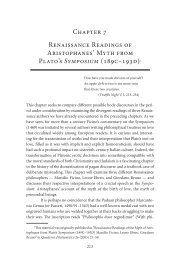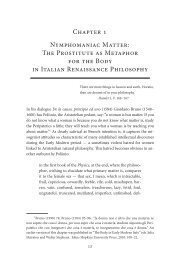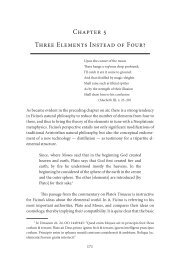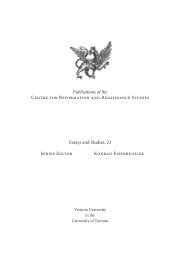Chapter 2 Matter as a Mirror: Marsilio Ficino and Renaissance ...
Chapter 2 Matter as a Mirror: Marsilio Ficino and Renaissance ...
Chapter 2 Matter as a Mirror: Marsilio Ficino and Renaissance ...
You also want an ePaper? Increase the reach of your titles
YUMPU automatically turns print PDFs into web optimized ePapers that Google loves.
<strong>Matter</strong> <strong>as</strong> a <strong>Mirror</strong> 91<br />
Like matter, the shadow is not completely deprived of being, the<br />
image in the mirror remains “a something” leading a life of its own. Here it<br />
becomes obvious that mirrors do not merely reflect, they also have the capacity<br />
to retain the forms they receive, like a womb. Actually, this is the obvious<br />
conclusion to be drawn from <strong>Ficino</strong>’s cosmology: we just have to remember<br />
that each hypost<strong>as</strong>is first behaves like a mirror/shadow/matter collecting the<br />
higher influence which it then independently transmits to the next lower<br />
echelon of being down to the bottom of creation. The process of creation thus<br />
requires that each hypost<strong>as</strong>is retain the images from above, transform them,<br />
<strong>and</strong> then reflect them onto the level beneath.<br />
It is interesting to note that the p<strong>as</strong>sage cited above st<strong>and</strong>s in pointed<br />
contradiction to modern readings of Plato’s doctrine of idola, such <strong>as</strong> Irigaray’s.<br />
According to her interpretation, Plato’s myth of the cave w<strong>as</strong> designed<br />
to rule out any sort of transformation occurring in the process of projection<br />
<strong>and</strong> reflection. 138 I do not wish to discuss Irigaray’s reading here, 139 but I would<br />
stress that according to <strong>Ficino</strong> the image in the mirror remains a “something”<br />
leading a life of its own. <strong>Ficino</strong> consequently parallels the qualities of matter<br />
beant, sicut mathematica suum.” According to Michael Allen, the source is Proclus (1970)<br />
II, 98–100. Allen (1989) 169 further argues: “It follows from the whole set of negative<br />
hypotheses in the Neoplatonist’s Parmenides […] that, since the One exists both absolutely<br />
<strong>and</strong> immanently, then not only do the realms of Mind, of Soul, of the corporeal forms, <strong>and</strong><br />
of body itself exist but also, in an unitary if unsubstantial way, does the realm of shadows<br />
<strong>and</strong> of dreams; <strong>and</strong> it exists immediately subordinate to the realm of corporeal forms <strong>and</strong><br />
material species upon which it directly depends <strong>and</strong> of which it is an imitation.” For a<br />
parallel comment, see Appendix in Timaeum 40, OO 1473: “Quae [sc. imagines] quidem<br />
nimis exilem habent essentiam, ut non aliter palam ostentare se oculis possint, quam in<br />
corporibus specularibus aequabiliter stabilitae, redintegratae, illustratae, pristinam vim<br />
qu<strong>and</strong>am modumquae formae, unde processere, recipiant.”<br />
138 Irigaray (1985) 309–310: “No proper value will be put upon the specular inversion<br />
that [this kind of] projection er<strong>as</strong>es by magic. Being, Good, Truth, the power of the<br />
Father are in no way amenable to being turned around. They go on <strong>and</strong> are eternally made<br />
manifest in their rectitude. With no back side or flip side. And the receptacle, the place of<br />
becoming, remembers nothing. Otherwise it would — perhaps — bear witness to the irreducible<br />
inversion that occurs in specula(riza)tion <strong>and</strong> in the re-production of any imprint,<br />
[…] even ideal ones. It must absolutely, not be known how much the procreation of the<br />
‘son,’ of the logos by the Father owes to inversion. Nor that the mother is the place where<br />
that inversion occurs.” See also Irigaray (1985) 331–333.<br />
139 Actually, Plato discusses the inversion that takes place in the mirror; see Timaeus<br />
46C <strong>and</strong> especially Theaitetus 193D.







